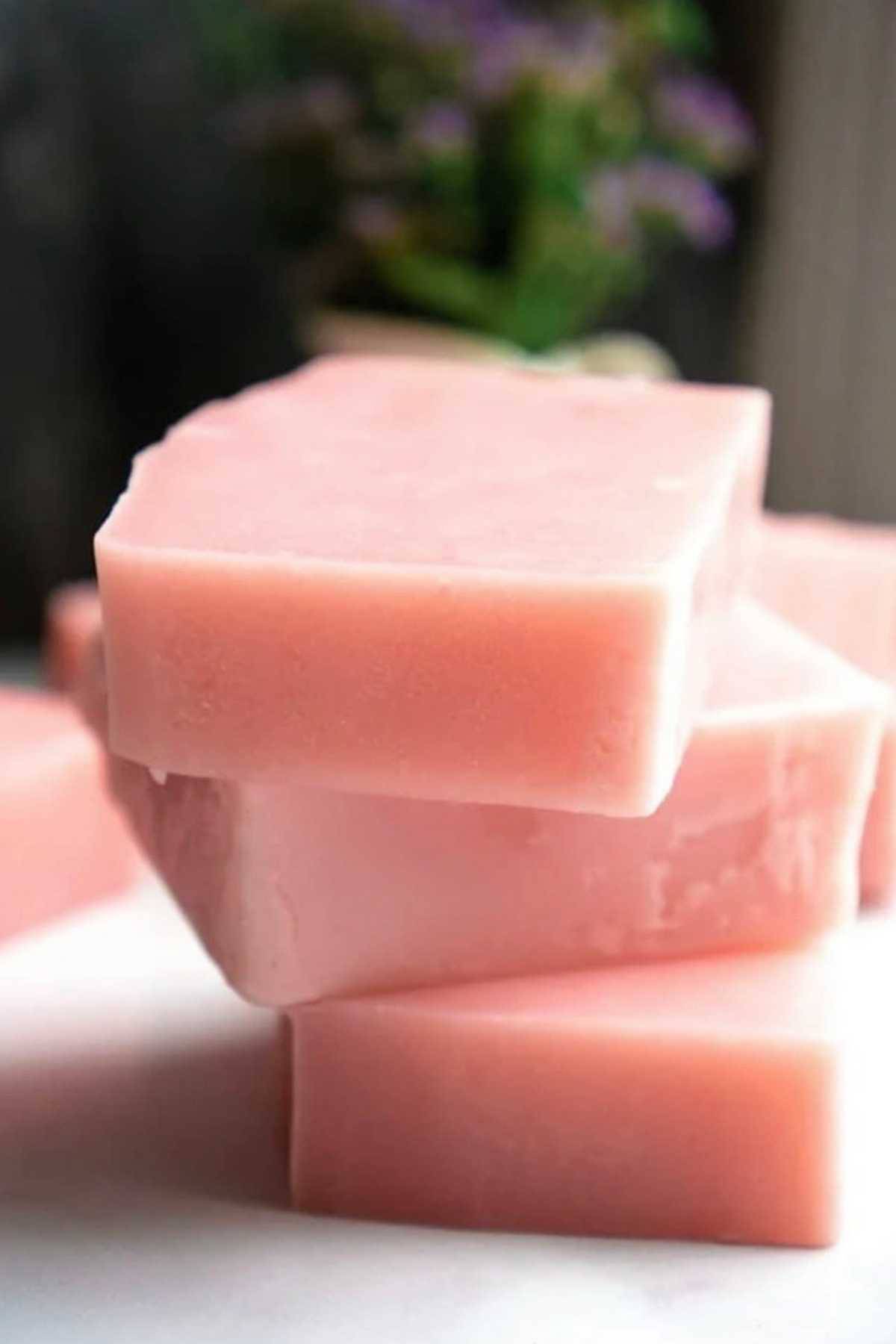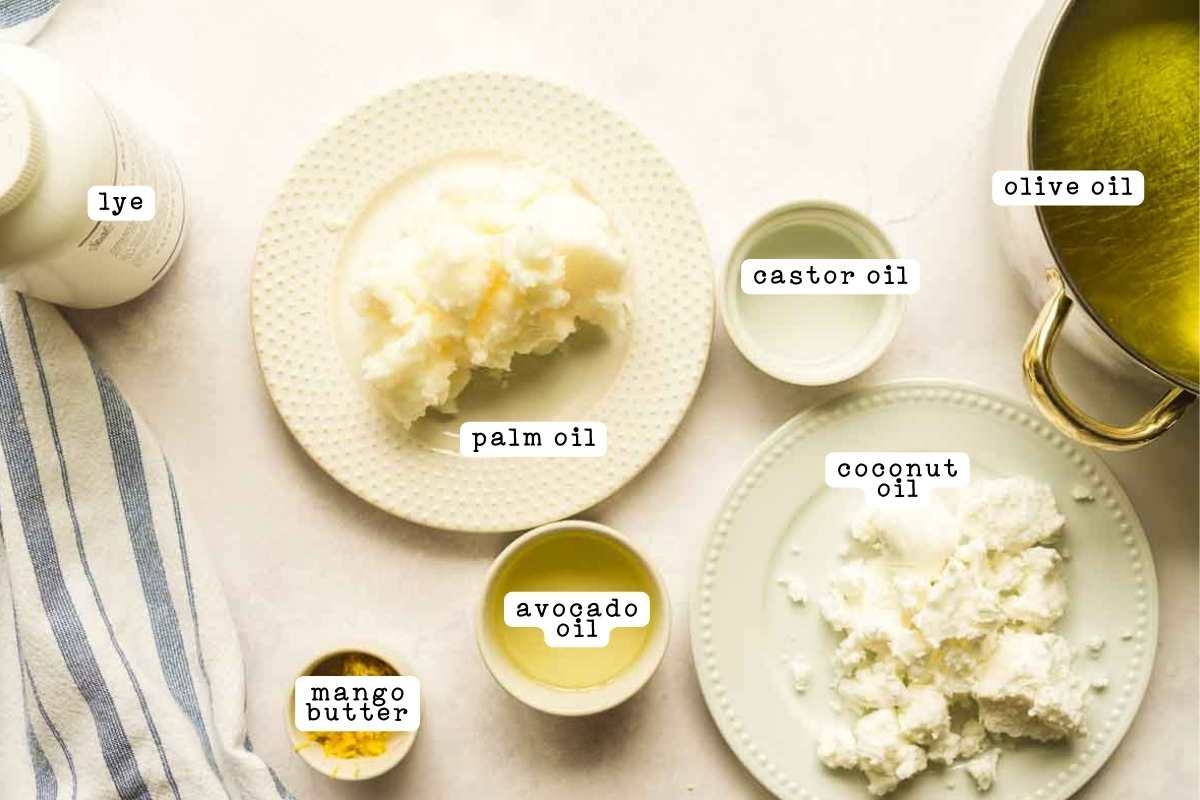How to Make the Best Cold Process Soap: Super Moisturizing and High Lather
This cold-process shower soap recipe is the best ever. It makes a moisturizing yet cleansing bar with tons of lather. Please read below the recipe for tips on substations, safety, and storage, as well as step-by-step photos. If you’re brand new to soapmaking, there’s a lot to learn! You’ll want to watch the video and read the whole post before you start.
The Best Cold Process Soap Recipe

Equipment
- Safety equipment (gloves, goggles, apron)
Ingredients
- 11 ounces coconut oil
- 9 ounces olive oil
- 9 ounces palm oil
- 2 ounces sweet almond oil
- 4 ounces castor oil
- 4 ounces avocado oil
- 2 ounces mango butter
- 5.83 ounces lye
- 10-15 ounces water
- 3 tablespoons fragrance oil for a strong scent, vary this to your preferences
- 2 teaspoons sodium lactate optional, for a harder bar
- colorant or mica optional
Save This Recipe
You'll join my email list which you will love. And if you don't, unsubscribe in one click. ❤️
Instructions
- Make lye water. Using a digital scale, measure out the lye and water in separate glass containers. Combine them by adding the lye to the water. (Remember: snow floats on the lake.). Stir until the lye dissolves. The temperature will shoot up. Place this in a safe place to cool.

- Melt oils and butters. While the lye solution is cooling, measure out the oils and butters and combine them in a large stainless pot. Melt them over low heat and heat them up to 130-140 degrees. Set them aside to cool.

- Let cool. After 2 hours, check the temperature of both solutions. They should be around 110 degrees. (A range of 100-120 is fine.). If not, allow them to cool longer.
- Prep for mixing. Prepare your mold and measure out any fragrance or color you will be adding. (For best blending of colors, mix some color into a few drops of melted oils.). If using sodium lactate, add it to the lye water at this time.
- Blend to trace. Pour the water and lye solution into the pot with the melted oils. Blend with a stick blender until thin trace is reached. The soap batter will noticeable thicken and a trail of soap will sit on top of the liquid rather than immediately sinking in. (This will take about 1 minute.). Add the color and fragrance and stir by hand.

- Pour in mold. Immediately pour the soap batter into the mold. Place in a turned-off oven or wrap with blankets to insulate the soap.

- Cut bars and let cure. After 24 hours of curing, unmold and cut into bars. The bars may seem slightly soft but will harden considerably during the curing process. Allow to cure at least 3 weeks in a well-ventilated place.

Video
Notes
Did You Make This?
I would love it if you would leave a review!
Ingredient Substitutions and Notes

- Coconut Oil: A staple in soap making, coconut oil provides a rich lather and hardness to the soap. It is highly cleansing and can strip away excess oil, making it ideal for oily skin types.
- Olive Oil: Known for its moisturizing properties, olive oil makes the soap smoother and less drying. It’s great for sensitive skin and contributes to the soap’s gentle cleansing ability.
- Palm Oil: Adds hardness to your soap bars, helping them maintain shape and last longer. It also contributes to lather quality, though it’s important to source sustainably due to environmental concerns.
- Sweet Almond Oil: This oil is excellent for its conditioning properties, adding softness and an elegant feel to the soap. It’s suitable for all skin types, especially dry skin.
- Castor Oil: A unique ingredient that boosts lather, making your soap rich and creamy. It’s also hydrating and helps draw moisture to the skin.
- Avocado Oil: Loaded with vitamins and minerals, avocado oil enhances the moisturizing power of your soap. It’s particularly good for dry and sensitive skin.
- Mango Butter: Provides a conditioning and moisturizing effect, making the soap more luxurious. Mango butter is rich in antioxidants and can help to soothe and soften the skin.
- Lye (Sodium Hydroxide): Essential for saponification, the chemical reaction that creates soap. Lye must be handled with care, but it is completely safe once the soap has cured.
- Water: Acts as a solvent for the lye and helps to control the saponification process. Distilled water is best to prevent any impurities from affecting the soap.
- Fragrance Oil: Adds a personal touch to your soap with your favorite scents. Quality fragrance oils are designed to be skin-safe and can significantly influence the sensory experience of using your soap.
- Sodium Lactate (optional): A salt solution that makes the soap bar harder and easier to unmold. While optional, it’s beneficial for achieving a smoother finish.
- Colorant or Mica (optional): These additives bring vibrant colors to your soap, enhancing its visual appeal. They can be used to achieve a wide range of artistic effects, like swirls or layers.
Storage Instructions
Once fully cured, homemade soap should be stored in a dry, well-ventilated spot. I like to put it in shoe boxes in the closet with layers of newspaper in between the bars.
While it is in use, use a soap saver to keep your bar dry. It will last much longer.
Common Issues and Fixes
A 10-inch silicone mold. It’s my favorite for most soaps.
If your soap is too soft, it might need more time to cure. Adding sodium lactate or using oils with higher stearic acid content can also help create a harder bar.
It is a pink mica from Nurture Soap. You can find it here.
Yes, absolutely. I’d recommend using sodium lactate since it can be a bit soft when unmolding it.
This is a 100% personal preference (except for the fact that florals are more difficult to work with). My personal favorites are Comfort and Joy from Nurture Soap and Mango Mango from Brambleberry.
Yes! I used to swirl it all the time before I got too lazy.
You sure can. You’ll need the following percentages:
Coconut Oil: 26.83%
Mango Butter: 4.88%
Olive Oil: 21.95%
Palm Oil: 21.95%
Sweet Almond Oil: 4.88%
Enter them into a soap calculator with the desired size of your batch and it will give you the correct amounts.
The gel phase is a part of the saponification process where the soap heats up and becomes translucent. This can help create a smoother, more uniform bar.
Yes, essential oils can be used as a natural alternative to fragrance oils. Just be sure to use skin-safe essential oils and follow recommended usage rates.
This recipe is a great way to start, but if it’s your first time, you might want to try a more basic recipe with fewer oils. Cold process soapmaking can be complex, so starting simple is a good idea.
Distilled water is free from impurities that can affect the chemical reaction during the saponification process. Using distilled water ensures a more consistent result.
More Great Cold Process Soap Recipes:
- Mix-ins are fun! Try this gardener’s soap recipe.
- You can make your own bar dish soap.
- If you’re looking for something palm-free, try my grapefruit soap bar.
As you continue soap-making journey, remember the importance of safety, stay patient and careful, and enjoy of crafting something with your own hands.
Love,















Hi katie
Can you please tell me how to calculate oil and lay ?in cold procsses soap? In simple method imam from India ndia and love watching your videos new in soap making ☺️
hi reeta i have a free booklet that lays it out. you can download it in my subscriber library. the password is: cozy
Love this recipe, it’s my first time making soap and I’ve made 3 loaves with this. Thank you for your detailed instructions. I seem to get soda ash on the tops even if I spray 99% isopropyl alcohol right away. I used 12oz of distilled water and soap between 100-110 degrees. Any suggestions?
hi jen! this happens to me sometimes still too because i like to soap at low temperatures. blending at higher temps will prevent this but it’s trickier in general. some people steam the tops of their soap but i’ve never tried that! honestly i wouldn’t worry too much about it, it’s just cosmetic.
This is my absolute FAVORITE soap recipe! It’s wonderfully moisturizing while bubbling beautifully. Thank you so much for sharing it with all of us. My family and I are grateful. ☺️
teresa i’m so happy you like it! we love the bubbles too!
I really appreciate your lecture and I wish one day I can. Be ableto blend my own my question is that can i use palm oil olive oil only or can I just use soyabean oil to do the same only thanks you I appreciate your tutorial ideas
Hi! I am a first time soap maker and I am excited to try your recipe. I have been reading and researching and prepping before I begin. My question is do you have to melt and heat the oils on the stove to the given temp or can I just melt in microwave? Thank you!
yes, you can! i would do it in bursts and stir in between. but it will work fine. 🙂
Hi Katie, when you made this recipe, what was the source of the SAP values that you used to calculate the solid lye (NaOH) quantity? There seems to be quite a range of values for each oil, depending on the supplier or on the online database source. For example, for avocado oil, I get a 177 to 230 range from the “fromnaturewithlove.com” saponification tables, while Bramble Berry just provides one value: 200. If I use the Bramble Berry values I get 6.1 oz of NaOH (for 5% superfat) for this recipe, but you are using 5.83 oz of NaOH, which would put you between 5 and 10%. If I rely on the wider range, then 5.83 oz lands me between 0.9% and 9.3% superfat.
hi gloria, i use the lye calculator from mountain sage: they use an average value for saponification from different suppliers.
You recipe is fantastic! Thank you so much for sharing it.
so happy you like it! 🙂
Since palm oil is destroying the planet and our kids deserve a place to live, do you have any recipes without palm oil?
I have a few, search for cold process baby soap and lemon soap they are both palm free.
I have been researching for months before trying to make soap for the first time and this was the recipe I tried. It is such a beautiful, creamy, bar that lathers like crazy which I absolutely love! After washing my hands with it they are not stripped what-so ever and is just moisturizing enough. Thanks for this recipe! I love your YouTube videos and you’ve taught me quite a bit of useful info on making cold process soap!
Hi Carma! Thank you so much for the kind note. I’m so happy you found a soap recipe that you love on the first try!
I’m interested in this soap recipe, but wonder if there’s a substitute for the palm oil and avacado oil; also could I use shea butter instead of mango? I’m just new at this, and I’m not exactly sure how to run this through a soap calculator. Thank you for you help!
hi WT: you can definitely make substitutions! if you don’t want palm or avocado oil you might like the lemon soap recipe i have. https://heartscontentfarmhouse.com/lemon-soap-recipe/ to just do a straight up substitution with THIS recipe, you could substitute babbasou oil for the palm oil (it’s expensive) and more almond oil for the avocado. but you would have to use a lye calculator to see if the lye amount changes. hope this helps 🙂
I just started making soap and would like to know what are your favorite scent recipes. I like a clean smelling soap
hi cheryl, my favorite clean fragrances are awaken (citrusy and fresh) and rosemary mint from nurture soap. they have a nice selection and sell in small sizes so you can try out a few. you can get them here: https://nurturesoap.com/collections/fragrance-oils?aff=326
If this recipe is drying out your skin and you want a vegan recipe, reduce the Coconut oil and skip the Palm. Sub with more olive oil or canola oil to be economical. Also be sure your lye formula is mild. 1:3 is a good rule of thumb ratio. Cover it to keep carbon absorption out. You can put a little of the butter aside and add it in with your choice of fragrance as well. I try to avoid fake fragrances because of my sentsative Irish girl skin. Jess, Barblender Soaps.
Hi. What is the super fat % for this recipe? N
5%
hello can I use grams instead of percentage
Great recipe! Can I leave out the mago butter?
you can try substituting shea butter or cocoa butter, but you’ll need to run it through a lye calculator to se if the lye amount changes.
This was great! I’m looking to make a three butter soap. Any tips?
so for the water amount do i use 10 or 15oz of water. its not really specific?
hallie, the amount of water is flexible in soap recipes. I typically go for an amount in the middle. less water and it will come to trace faster and the bars will cure faster, it just give you less time to add fragrance, etc before the soap sets up. a higher amount of water and you have more time to work but the bars will need more time to cure. its just personal preference.
I wanted to make your recipe but convert it into grams , do you have the % for each ingrediant so i can convert it ?
hi Anna! there are very annoying decimals involved, unfortunately! 🙂
Avocado Oil: 9.76%
Castor Oil: 9.76%
Coconut Oil: 26.83%
Mango Butter: 4.88%
Olive Oil: 21.95%
Palm Oil: 21.95%
Sweet Almond Oil: 4.88%
Hello! I have made many batches of this soap and the soap has cured for 4 weeks. I used one of the bars last evening and it was very drying to my hands. They felt tight etc. I love the recipe and all the ingredients. Any thoughts? Will curing longer help?
Pamela, do you mean previously batches have turned out well but this particular one did not? It could have been a measuring error- leaving out a certain oil and thus too much lye, or something like that. if you mean that all of your batches have been too drying, I would recommend increasing the superfat to 7%, but it will be a softer bar. 🙂
I made your recipe the other day and I absolutely loved it! So tonight I made it a second time, it’s been poured and sitting in the mold for a couple hours now. I just realized that I forgot to add the avocado oil! ???? How bad have I messed this up? I’m a new soaper, please help.
so the main issue that the lye is going to be a bit out of whack. there won’t be enough oils to balance out the lye. what I would do is use a soap calculator and input the recipe as you made it. see what the superfat percentage comes out to. if it’s below 4, it’s probably too harsh to use on your skin 🙁 but you could use it as a cleaning soap! here is my favorite lye calculator: https://www.the-sage.com/lyecalc/
Hi Katie
I am planning to make this soap and it will be my first time! A soap virgin. Where does the pink colouring come from? I love it and want my soap to look just like that!
Wish me luck.
hi Deirdre! how exciting! the pink is a pink mica! you can add it at trace until you get the color you want. my favorites pink is this one: cantaloupe mica